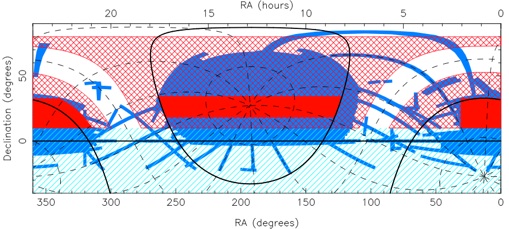Astronomy Research

Precision mapping of the chemodynamical structure of the Milky Way is an essential prerequisite to understanding its formation and evolution. Luau is a Large Program on CFHT that runs from January 2015 - December 2016. In this first phase, we are surveying ~3500 square degrees of the northern sky to obtain deep u band imaging to an approximate depth of u~24.5. When combined with existing SDSS griz PanSTARRS grizy data, we will make the most precise reconstruction of the metallicity structure of the Galaxy by mapping the distances and metallicities of >10 million main sequence stars. Luau can identify every blue horizontal branch star to half the virial radius of the Galaxy, and produce the definitive catalog of disk and halo white dwarfs within 1kpc. The legacy value of these data both in and beyond Galactic astronomy is immense.
Luau: the Legacy for the u-band all sky Universe
Dwarf galaxies are almost certainly governed by the same physics as their more massive counterparts. The fact that they are expected to be more sensitive to the processes that drive galaxy formation and evolution makes them exceptionally interesting systems in which to study these processes. Almost all of our most detailed information on dwarf galaxies, however, comes from the satellite system of the Milky Way. Solo is a wide field multi-band survey of every dwarf galaxy within 3 Mpc that is not a satellite of either the Milky Way or M31. When viewed as a population, the Solo dwarfs are potentially a powerful benchmark for studies of the interplay between secular and environment-driven galaxy evolution at the low mass end through comparison to studies of dwarf satellite systems.
Solo: The Solitary Local Dwarfs Survey
My research interests cover all aspects of galaxy formation and evolution, particularly in relation to the nearest galaxies and their resolved stellar populations. For the closest systems - including our own Milky Way - we can perform Galactic Archaeology and use the positions, dynamics, ages and chemical properties of the resolved stars to reveal the evolutionary paths of these galaxies. This approach perfectly complements observations of the more distant Universe, where we see snapshots of many more galaxies at earlier stages in their evolution, but for which much less detailed information is available.
Below, I briefly describe a few of the larger projects that I currently lead or co-lead. I am always keen to work with students interested in any of these, or related, areas.
Click here to see recent papers on these and other projects.
PAndAS: the Pan-Andromeda Archaeological Survey
PAndAS is based on deep g and i imaging of over 450 square degrees of sky centered on M31 and M33. It maps the structure of these galaxies to unprecedented depths over an unprecedented volume (out to ~half the virial radius of the dark matter halo) and reveals a vast array of structures, stellar streams, satellites and globular clusters. Nearly 20 new Local Group galaxies have been discovered in PAndAS, in addition to 100 new globular clusters. PAndAS is arguably the most direct, visual confirmation of the ongoing hierarchical build-up of galaxies, as revealed by close inspection of their faint stellar outskirts.
Link to the PAndAS webpage


